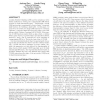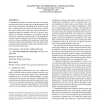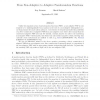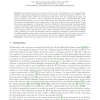102
click to vote
SIAMCOMP
2012
13 years 8 days ago
2012
Abstract. In the framework of Carter and Wegman, a k-independent hash function maps any k keys independently. It is known that 5independent hashing provides good expected performan...
122
click to vote
CVPR
2012
IEEE
13 years 8 days ago
2012
IEEE
Recent years have witnessed the growing popularity of hashing in large-scale vision problems. It has been shown that the hashing quality could be boosted by leveraging supervised ...
CRYPTO
2012
Springer
13 years 9 days ago
2012
Springer
Liskov, Rivest and Wagner formalized the tweakable blockcipher (TBC) primitive at CRYPTO’02. The typical recipe for instantiating a TBC is to start with a blockcipher, and then b...
INFOCOM
2012
IEEE
13 years 9 days ago
2012
IEEE
Abstract—In this paper, we implement and evaluate three different Byzantine Fault-Tolerant (BFT) state machine replication protocols for data centers: (1) BASIC: The classic solu...
108
click to vote
SIGMOD
2012
ACM
13 years 9 days ago
2012
ACM
Locality-Sensitive Hashing (LSH) and its variants are wellknown methods for solving the c-approximate NN Search problem in high-dimensional space. Traditionally, several LSH funct...
111
click to vote
SIGCOMM
2012
ACM
13 years 9 days ago
2012
ACM
A fundamental problem in wireless networks is to develop communication protocols that achieve high throughput in the face of noise, interference, and fading, all of which vary wit...
IACR
2011
13 years 9 months ago
2011
The Keccak hash function is one of the five finalists in NIST’s SHA-3 competition, and so far it showed remarkable resistance against practical collision finding attacks: Afte...
IACR
2011
13 years 9 months ago
2011
Unlike the standard notion of pseudorandom functions (PRF), a non-adaptive PRF is only required to be indistinguishable from random in the eyes of a non-adaptive distinguisher (i....
IACR
2011
13 years 9 months ago
2011
Abstract. GOST 28147-89 is a well-known block cipher and the official encryption standard of the Russian Federation. Its large key size of 256 bits at a particularly low implementa...
IACR
2011
13 years 9 months ago
2011
Abstract. Sponge functions were introduced by Bertoni et al. as an alternative to the classical MerkleDamg˚ard design. Many hash function submissions to the SHA-3 competition laun...





